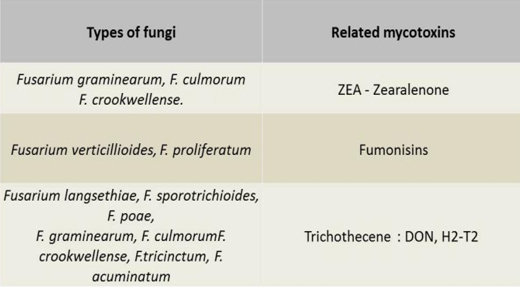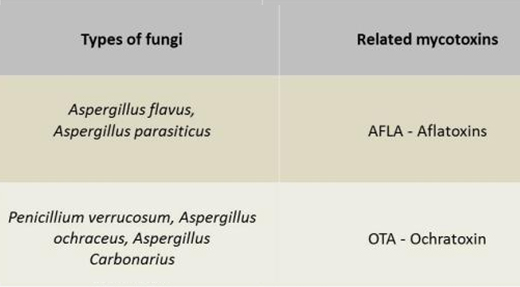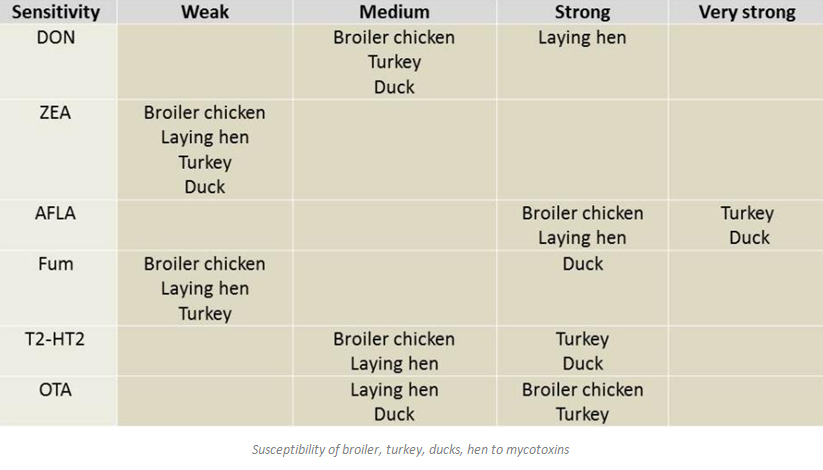Products
- Home
- Products

Emergency Cases
011-42544599Mycotoxins Management

Mycotoxins are secondary metabolites of molds that have adverse effects on humans, animals, and crops that result in illnesses and economic losses. The worldwide contamination of foods and feeds with mycotoxins is a significant problem. Aflatoxins, ochratoxins, trichothecenes, zearalenone, fumonisins, tremorgenic toxins, and ergot alkaloids are the mycotoxins of greatest agro-economic importance. Some molds are capable of producing more than one mycotoxin and some mycotoxins are produced by more than one fungal species.

Field mycotoxins
Mycotoxins that form before harvest are called field mycotoxins. Field mycotoxins are usually secreted by fungi on cereals. As cereals grow in fields, some climates and technical methods are especially likely to lead to the emergence of these mycotoxins. A simplified tillage or a corn that appears before wheat are among these risk factors.

Storage Mycotoxins
Storage mycotoxins develop after harvest. Their presence is favored by moisture on cereals, by a mix of moist grains with dry ones or when the difference between the temperature levels within the silos where grains are stored is too high. Although these two categories of mycotoxins differ with regards to the period when they appear, both are just as dangerous for animals'health. They can have severe effects on animals' health in cases of high levels of contamination. More minor instances of contamination are more insidious in their effects, which are generally manifested by an overall decrease in performance.
Performance declines by species
poultry species are more vulnerable to mycotoxins. Different species of chicken (chicken, turkey, duck, laying...) vary in their level of vulnerability to different kinds mycotoxin.

Mycotoxin : Prevention is better than cure .
To prevention we have solution
Gut Health Management

Good health starts in the gut
Digestive health is a main concern in the poultry industry as it has a high impact on production and mortality rates caused by gut diseases. Traditionally, sub-therapeutic doses of antibiotics have been used as a strategy to improve gut flora, prevent diseases, and enhance growth performance. However, such approach has been discouraged as it poses significant risks to both animal and public health. Indeed, since 2006, the European Union banned the use of antibiotics as growth promoters in livestock production.
The poultry industry has been looking for safer alternatives to antibiotics that could contribute to preserving gut health of broiler chickens, while simultaneously acting as growth promoters. Feed supplementation with probiotics , Phytochemicals ,Yeast and Acidifiers have been proven to be one of the most promising approaches to replace antibiotics due to the notable health and performance benefits.
We have a good range of Gut health solution .
Exogenous Enzymes

Cereals such as corn, wheat, barley, rye etc. are incorporated into animal feed to provide a major source of energy to monogastric animals. However, much of the energy remains unavailable due to the presence of non-starch polysaccharides (NSP). NSP creates high gut viscosity and interferes with digestion.
Phytase :
Around 50-80% of the total phosphorous in pig and poultry diets is present in the form of phytate (also known as phytic acid). The phytate-bound phosphorous is largely unavailable to monograstric animals as they do not have the enzyme needed to break it down.
Additionally, phytate in animal manure is degraded by soil microoganisms leading to high levels of free phosphate in the soil and eventually, the surface water. This is harmful to the environment.
Carbohydrase enzymes have been proven to be effective in increasing the amount of energy available from feed ingredients. Key carbohydrase enzymes include amylase and xylanase and are used to improve the digestibility of carbohydrates in feed ingredients. This improved digestibility increases the availability of energy in the small intestine to help promote growth and other productive processes.Corn provides a majority of the energy in a typical poultry diet. Amylase is a starch digesting enzyme that helps to digest more of the starch found in corn. Amylase increases starch digestibility, thus providing more available energy. Xylanase, on the other hand, releases energy from the fibrous portion of grains and grain byproducts.
Protease is a protein digesting enzyme that breaks down storage proteins binding starch within feed ingredients. This makes the energy from protein bound starch available to the bird to be used for productive purposes. Proteases are also effective in releasing protein anti-nutrients found in ingredients like soybean meal. This function of proteases makes proteins more available. A combination of amylase, xylanase, and protease enzymes working together to each attack different poorly digestible portions of feed ingredients increases energy available for growth and/or egg production. The addition of these three enzymes to the diet in combination typically increases energy available to birds by 3 to 5%.
Enzyme Innovation's Super E2® range is the answer to all of these challenges faced by the feed industry.
- Solutions for poultry, swine & cattle
- Increased profitability
- Reduction in feed cost
- Healthy animals
- Reduced environmental pollution
Solution For Coccidiosis

Coccidiosis is a realistic problem and one of the most important diseases of poultry worldwide. It is caused by a protozoan parasite known as Eimeria that invade the cells of the poultry intestine. Species of coccidia which commonly affect poultry are Eimeria tenella, E. acervulina, E. necatrix, E. maxima and E. brunetti. The disease is characterised by enteritis, diarrhoea and mortality. The bird develops reduced ability to absorb nutrients, which results in weight loss and eventually death. Subclinically, it is manifested by poor performance, impaired feed conversion, poor flock uniformity and poor growth. Coccidia can also damage the immune system and leave poultry more vulnerable to pathogens like Clostridium, Salmonella and E. coli.
The Battle Against Coccidiosis
An outbreak of coccidiosis in a poultry flock has a very high negative and economical impact on the flock as well as for the poultry producer. There is an immediate and considerable drop in production figures and the recovery and reestablishment period after treatment is slow. Some flocks never fully recover or regain their full production potential. Hence, it is a well-recognised fact that treatment alone cannot prevent the economical losses. It is well established within the poultry sector that the only choice is therefore prevention of the disease. However, an effective and sustainable prevention and control programme against the disease is not easy.
Solution for Mycoplasmosis

Mycoplasmosis is caused by several species of pathogenic Mycoplasma bacteria. The most relevant species in Pennsylvania include M. gallisepticum, M. synoviae, and M. meleagridis. Most disinfectants are effective against Mycoplasma, but once inside the host, the organism is very persistent. This genus of bacteria lacks a cell wall, unlike most typical bacteria. Therefore, when considering antibiotic treatment, it is important to avoid those antibiotics which target the cell wall. The antibiotics tylosin, tilmicosin, and tiamulin are useful to reduce the Mycoplasma load in the flock and alleviate clinical symptoms
Clinical signs
Typical respiratory signs, including conjunctivitis, facial edema, tracheal rales, coughing, and nasal discharge, are commonly seen in birds with mycoplasmosis. Sinusitis is especially common in turkeys. Nostrils often appear dirty due to feed particles adhering to the mucus on the nostril surface. M. synoviae tends to produce a more benign infection, but it can become systemic, resulting in synovitis affecting joints and tendon sheets. Inflamed and uneven hocks may be seen; severe cases will result in lameness. Mortality is usually low in uncomplicated cases, especially in mature animals. Co-infection of lesions with other agents (e.g. E. coli) can result in more severe clinical signs and increased mortality. In laying birds, egg production may be affected, especially in unvaccinated flocks. Infection of embryos results in reduced hatchability, particularly due to increased numbers of pipped embryos that are unable to complete the hatching process.
Occurrence
M. gallisepticum is distributed worldwide, affecting chickens, turkeys, ducks, pheasants, quail, and partridges. M. synoviae, which affects chickens and turkeys, is also widely distributed. M. meleagridis is only present in turkeys. The incubation period is slow and highly variable (1-3 weeks). Dissemination within the flock is also slow; thus in general, mycoplasmosis occurs in birds older than 4-5 weeks of age. The appearance of clinical signs seems to be related to stress factors. For example, it is common for layers to be infected at 6-10 weeks of age, but clinical signs may not appear until sexual maturity and egg production (after 18 weeks of age). The disease is most common in layer farms because animals remain carriers of the organism, even after treatment.
Transmission
The main portals of entry are the conjunctiva and the respiratory epithelium. Infected breeders transmit the infection to the eggs, contaminating the embryos. Horizontal transmission occurs after contaminated embryos hatch. Fomites are an important mechanism for horizontal transmission. It is important to note that wild songbirds can also be infected with M. gallisepticum and serve as reservoirs for the organism. Because previously infected birds will remain carriers of the organism even in the absence of clinical signs, this disease is impossible to eliminate in facilities that do not practice "all-in all-out."
The Science of AGP

Anti-biotic Growth Promoters (AGP‟s) are commonly used in the poultry industry, principally in broiler diets but they may also be used in layer diets. As an industry, we have access to almost all of the AGP‟s ever developed. AGP‟s have characteristics that help explain their position as the additives of choice for growth promotion. In general, they are extremely effective at remarkably low doses and they are relatively cheap, thus yielding a significant return on investment.
Vitamins Premix
Vitamins are a group of organic compounds that poultry only require in small quantities, but they are essential for normal body functions, growth, and reproduction, A deficiency of one or more vitamins can lead to a number of diseases or syndromes.
Vitamins are divided into two categories: fat-soluble and water-soluble. The fat-soluble vitamins are A, D, E, and K. The water-soluble vitamins include vitamin C and the B vitamins.
Vitamin D3 is required for proper absorption and utilisation of calcium and phosphorous, which are required for normal growth, bone development, and eggshell formation.
Vitamin D can be produced when sunlight hits the bird's skin. Deficiency leads to rickets. Birds produce thin shelled eggs with reduced hatchability, show leg weakness and penguin like sitting posture. The beak, claws and ribs become very pliable. Characteristic feature is the bending of sternum and spinal column. Fish liver oils are rich sources of vitamin D.













